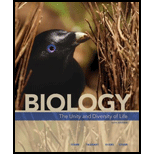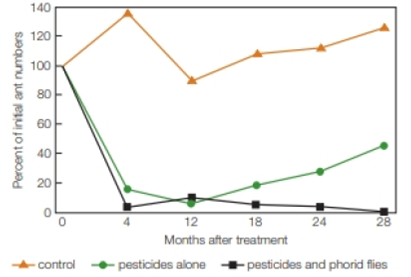
Testing Biological Control Biological control agents are used to battle red imported fire ants. Researchers have enlisted the help of Thelohania solenopsae, a natural enemy of the ants. This microsporidian (Section 23.4) is a
Are these biological controls useful against imported fire ants? To find out, USDA scientists treated infested areas with either traditional pesticides or pesticides plus biological controls (both flies and the parasite). The scientists left some plots untreated as controls. FIGURE 45.16 shows the results.

FIGURE 45.16 A comparison of two methods of controlling red imported fire ants. The graph shows the numbers of red imported fire ants over a 28-month period. Orange triangles represent untreated control plots. Green circles are plots treated with pesticides alone. Black squares are plots treated with pesticide and biological control agents (parasitoid flies and a microsporidian parasite).
How did
To determine: The variation in population size in the given control plots during the first four months of the study.
Introduction: Biological control agents are the natural enemies like predation, parasitism, and other methods that are used to control the pests like weeds, insects, mites, nematodes, and so on in order to generate a pest-free- yields. The biological control agent such as Thelohania solenopsae is a natural enemy of the red imported fire ants. This microsporidian can decline the ant’s colony by infecting and shrinking the ovaries of the queen which are the female reproducing ants.
Explanation of Solution
The USDA scientists conducted a study by treating the infected area by using the traditional pesticides and pesticides with biological controls. They kept some plots as controls that are untreated. They observed that the red imported fire ants over a period of 28 months.
Refer Fig. 45.16, “A comparison of two methods of controlling red imported fire ants” in the textbook. The graphical representation shows the percentage of the number of ants versus the months of treatment. The orange triangle indicates the control plots that are untreated. The green circle indicates the plots that treated using pesticides alone and the black square indicates the plots that treated using pesticide with biological control agents (using both parasite and flies).
During the first four months of the treatment, the variation in the population size of the control plots of fire ants increased. Initially, the percentage of the number of ants was 100%. However, after first four months, it had increased to 140%. Hence, there was a variation of about 40%.
Want to see more full solutions like this?
Chapter 45 Solutions
Biology: The Unity and Diversity of Life (MindTap Course List)
Additional Science Textbook Solutions
Biological Science (6th Edition)
Laboratory Manual For Human Anatomy & Physiology
SEELEY'S ANATOMY+PHYSIOLOGY
Biology: Life on Earth with Physiology (11th Edition)
HUMAN ANATOMY
Campbell Essential Biology (7th Edition)
- Explain how the hormones of the glands listed below travel around the body to target organs and tissues : Pituitary gland Hypothalamus Thyroid Parathyroid Adrenal Pineal Pancreas(islets of langerhans) Gonads (testes and ovaries) Placentaarrow_forwardWhat are the functions of the hormones produced in the glands listed below: Pituitary gland Hypothalamus Thyroid Parathyroid Adrenal Pineal Pancreas(islets of langerhans) Gonads (testes and ovaries) Placentaarrow_forwardDescribe the hormones produced in the glands listed below: Pituitary gland Hypothalamus Thyroid Parathyroid Adrenal Pineal Pancreas(islets of langerhans) Gonads (testes and ovaries) Placentaarrow_forward
- Please help me calculate drug dosage from the following information: Patient weight: 35 pounds, so 15.9 kilograms (got this by dividing 35 pounds by 2.2 kilograms) Drug dose: 0.05mg/kg Drug concentration: 2mg/mLarrow_forwardA 25-year-old woman presents to the emergency department with a 2-day history of fever, chills, severe headache, and confusion. She recently returned from a trip to sub-Saharan Africa, where she did not take malaria prophylaxis. On examination, she is febrile (39.8°C/103.6°F) and hypotensive. Laboratory studies reveal hemoglobin of 8.0 g/dL, platelet count of 50,000/μL, and evidence of hemoglobinuria. A peripheral blood smear shows ring forms and banana-shaped gametocytes. Which of the following Plasmodium species is most likely responsible for her severe symptoms? A. Plasmodium vivax B. Plasmodium ovale C. Plasmodium malariae D. Plasmodium falciparumarrow_forwardStandard Concentration (caffeine) mg/L Absorbance Reading 10 0.322 20 0.697 40 1.535 60 2.520 80 3.100arrow_forward
- please draw in the answers, thank youarrow_forwarda. On this first grid, assume that the DNA and RNA templates are read left to right. DNA DNA mRNA codon tRNA anticodon polypeptide _strand strand C с A T G A U G C A TRP b. Now do this AGAIN assuming that the DNA and RNA templates are read right to left. DNA DNA strand strand C mRNA codon tRNA anticodon polypeptide 0 A T G A U G с A TRParrow_forwardplease answer all question below with the following answer choice, thank you!arrow_forward
 Biology 2eBiologyISBN:9781947172517Author:Matthew Douglas, Jung Choi, Mary Ann ClarkPublisher:OpenStax
Biology 2eBiologyISBN:9781947172517Author:Matthew Douglas, Jung Choi, Mary Ann ClarkPublisher:OpenStax Biology: The Dynamic Science (MindTap Course List)BiologyISBN:9781305389892Author:Peter J. Russell, Paul E. Hertz, Beverly McMillanPublisher:Cengage Learning
Biology: The Dynamic Science (MindTap Course List)BiologyISBN:9781305389892Author:Peter J. Russell, Paul E. Hertz, Beverly McMillanPublisher:Cengage Learning Biology (MindTap Course List)BiologyISBN:9781337392938Author:Eldra Solomon, Charles Martin, Diana W. Martin, Linda R. BergPublisher:Cengage Learning
Biology (MindTap Course List)BiologyISBN:9781337392938Author:Eldra Solomon, Charles Martin, Diana W. Martin, Linda R. BergPublisher:Cengage Learning Biology Today and Tomorrow without Physiology (Mi...BiologyISBN:9781305117396Author:Cecie Starr, Christine Evers, Lisa StarrPublisher:Cengage Learning
Biology Today and Tomorrow without Physiology (Mi...BiologyISBN:9781305117396Author:Cecie Starr, Christine Evers, Lisa StarrPublisher:Cengage Learning Human Heredity: Principles and Issues (MindTap Co...BiologyISBN:9781305251052Author:Michael CummingsPublisher:Cengage Learning
Human Heredity: Principles and Issues (MindTap Co...BiologyISBN:9781305251052Author:Michael CummingsPublisher:Cengage Learning





